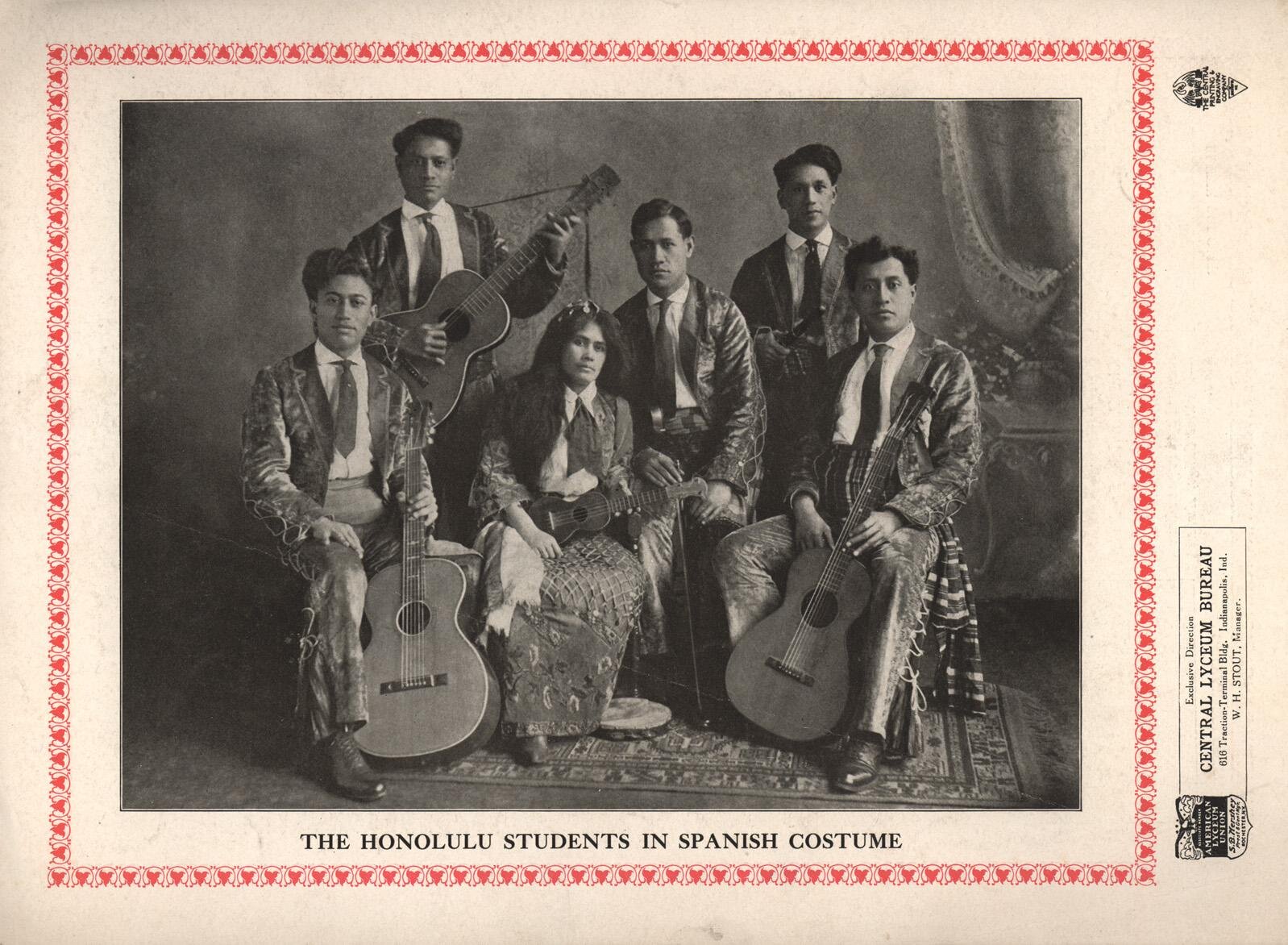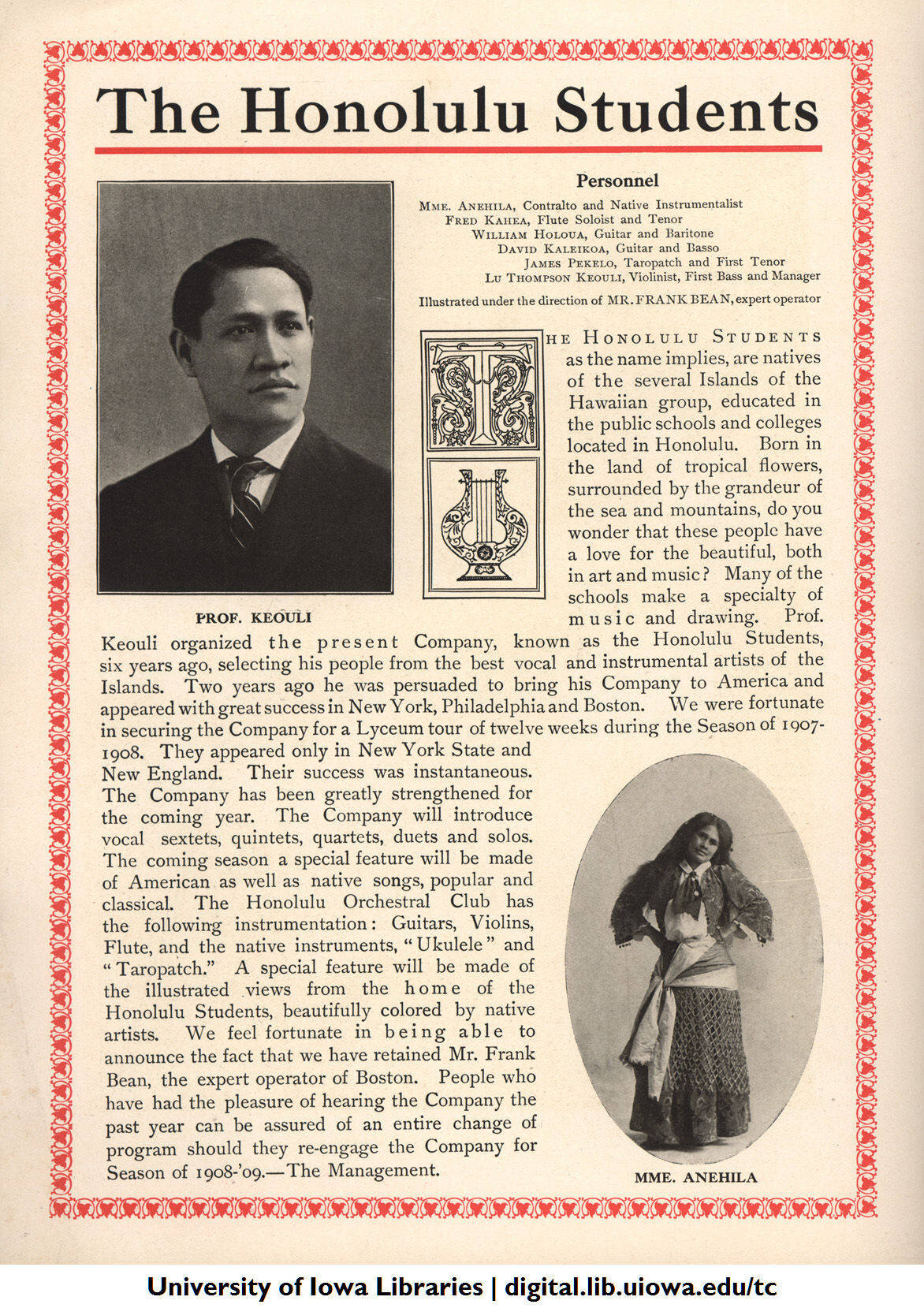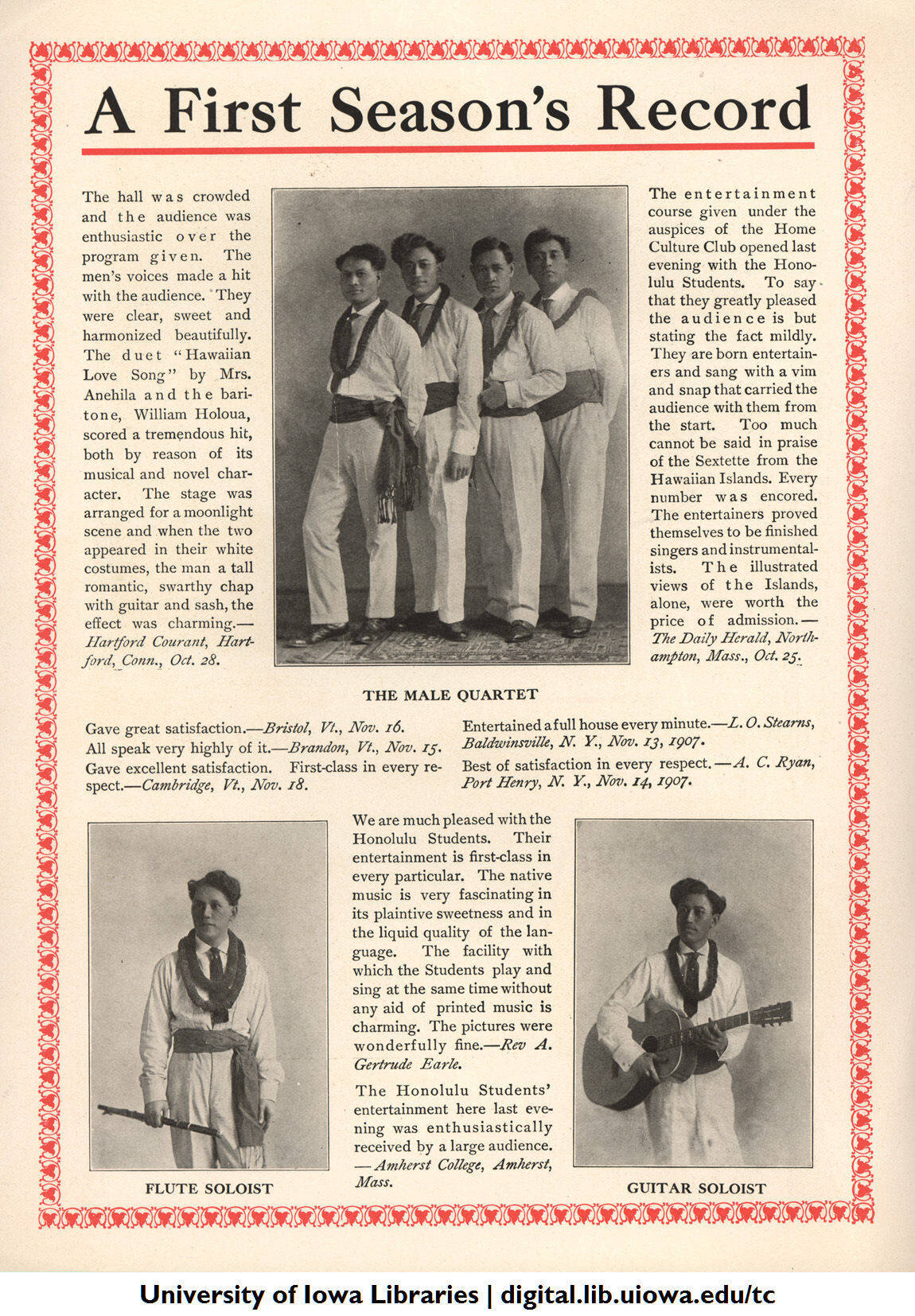Royal Hawaiian Troubadors The Honolulu Students CD Released!
The recordings on this CD were made just after the turn o fthe 20th century, and have roots in an era before music had ever begun to be captured and recorded, a time when if you were not playing music yourself or listening to someone else play, you simply were not hearing music at all. They represent a time when a monumental shift in our relationship to sound was taking place, a shift that would change not only how we interact with music, but also how we relate to the people that bring music to life before us. The widespread capture and resale of sound that soon followed led directly to the birth of the musical genre- a system of classification made in the interest of marketing this newly harnessed commodity.
The extraordinary discovery of this music owes itself to an old-fashioned pilgrimage to the reading room at the American Folklife Center at the Library of Congress in Washington D.C., while researching the life of prolific Hawaiian composer and multi-instrumentalist Mekia Kealakai. A chance conversation with a gracious librarian revealed a collection of old records performed by a Hawaiian string band alternately calling itself the Royal Hawaiian Troubadors and the Honolulu Students. Born in 1882, bandleader of the Honolulu Students, Lui Thompson got his start playing in Mekia Kealakais Hawaiian orchestra on a tour across the U.S. in 1901.
Hawaiian musical ensembles began touring the continent long before there was such a thing as the “Continental United States”. For much of the 19th century, the port city of Honolulu was the largest and most cosmopolitan crossroads in the Pacific region, trading music and commercial goods extensively with the Mexican cities of Sacramento, San Francisco, Los Angeles, and Vera Cruz, as well as the Russian fur trading posts of the Alaskan territory.
At age 19, Lui Thompson performed with Kealakai playing violin at the 1901 Buffalo World’s Fair. He later recalled hearing President William McKinley’s last speech before his assassination in the music building of the fairgrounds later that day. Three years earlier, President McKinley had been instrumental in forcing the illegal annexation of the Hawaiian Kingdom through the United States Congress, making Hawai’i a U.S. Territory.
To many fans of early American “Roots” music and string bands like the Carter Family and Jimmie Rodgers, these recordings may sound curiously familiar. Jimmie and the Carters all grew up in a southern culture steeped in the influence of string-slinging Hawaiian troubadors like the ones featured in this music, and they regularly played hte Hawaiian steel guitar in their performances. These recordings were made more than twenty years before talent scout Ralph Peer, working for what would eventually become known as Victor Records, first recorded Jimmie and the Carters on his portable recording machine in 1927.
Available for the first time in 115 years, these recordings are arguably the earliest complete sessions of a traveling string band in existence. They give us a glimpse into a time when string musicians relied solely upon the strength of their hands and voices to entertain millions of listeners at Worlds Fairs, traveling tent shows and Vaudeville theaters. These songs are played by a band of young musicians on the road, recorded at the beginning of their careers, and likely in the style the composers originally intended.
The fact that this band is made up exclusively of Hawaiian musicians is a detail we believe to be worthy of deep and prolonged attention by anyone looking for the origin story of what we today call “American” music. In addition to songs written by Mekia Kealakai, this CD includes several compositions by Hawaiian royalty, including pieces by Prince William Pitt Leleiōhoku, Queen Lydia Lili’uokalani and King David Kalākaua. Their songs can still be heard today in Hula competitions, jam sessions, and in hotels along the shoreline of Waikīkī Beach.
We hope that you can find time to quiet the digital signals in your modern life and listen to the tones in these voices, the timing of the phrasing and arrangements. This music was made before America ha dever heard its own soundtrack- before there were distinctions between folk, blues, jazz, Hawaiian, hillbilly, and ethnic music. These recordings were made at a time when Hawaiian musicians like these heard here were living and traveling in America as refugees from an occupied motherland. They traveled by rail, sail and horse drawn wagon, teaching a young and fast -growing nation how to string its strings and find its voice.
Mahalo nui loa, -Kilin Reece
The Hawaiian Mandolin Project
The Mandolin in 19th century Hawaii was a popular instrument, much as it was across the continental "Mainland" of the United States. Mandolin clubs, orchestras and quartets were not uncommon among many of the early Royal Hawaiian Band musical programs, and the Opera house in Honolulu regularly hosted Mandolin focused shows often led by the King of the Hawaiian Mandolin, and a leading educator of his day Ernest Kaai.
Ernest Ka'ai-Hawaiian string virtuoso- b.1881-d.1962
Mr. Ka'ai ran his own Mandolin school in Honolulu, and was said to have been the greatest of the many Hawaiian Mandolin players at the turn of the last century, reported to have been able to accompany himself in a chord melody/tremolo style all his own. Ernest went on to travel extensively throughout the world like many of his contemporaries, inspiring people everywhere he went to study Hawaiian music and dance.
Johnny Kameaaloha Almeida b.1897-d.1985
Mr. Almeidas playing stopped me dead in my tracks, with a right hand attack and tremolo rivaling any early Monroe Brothers recording, paired with the intervalic leaps and the harmonic map of Django Reinhardt, Johnny is truly one of the world wide greats in the history of Mandolin music. I happened upon a dusty box of 78s here in Kailua on the eastern side of Oahu, all of which bore the tattered labels from the 49th State label, of which I would later find out Johnny was the musical director -leading the recording sessions with his trusted mandolin. Johnny is also one of the most respected composers of Hawaiian language compositions and was a native speaker of the Hawaiian language.
Traditional Hawaiian Violin
Evidence of violins in Hawaiian music can be traced back to about 1815. The violin and flute were often the preferred instruments for melody in leading string ensembles up through the end of the 19th century, and it was not uncommon for violinists to double on mandolin. Contrary to what many string players think today, steel strings were actually less expensive than gut strings.
String Traditions of Hawai'i and the Pacific
Please visit the Kealakai Center for Pacific Strings website for more information on our historical work celebrating Hawai'i and the Pacific region's legacy in the luthiery and the musical arts.











